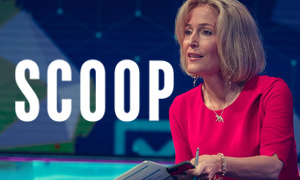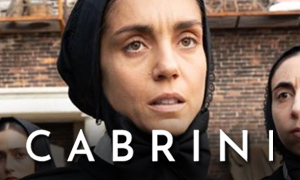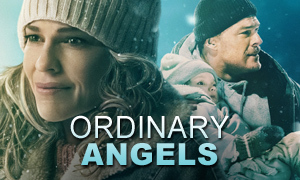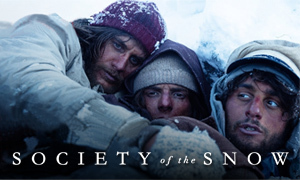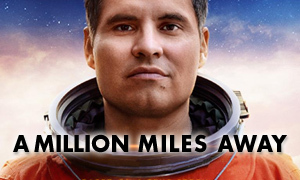Jobs: History vs. Hollywood
For the movie starring Michael Fassbender, see Steve Jobs (2015)
Starring Ashton Kutcher, Josh Gad, Dermot Mulroney, Matthew Modine, James Woods | based on the life of Steve Jobs from 1971 to 2000
| REEL FACE: | REAL FACE: |
Ashton Kutcher
Born: February 7, 1978 Birthplace: Cedar Rapids, Iowa, USA | Steve Jobs
Born: February 24, 1955 Birthplace: San Francisco, California, USA Death: October 5, 2011, Palo Alto, California, USA (pancreatic cancer) |
Josh Gad
Born: February 23, 1981 Birthplace: Hollywood, Florida, USA | Steve "The Woz" Wozniak
Born: August 11, 1950 Birthplace: San Jose, California, USA |
Dermot Mulroney
Born: October 31, 1963 Birthplace: Alexandria, VA, USA | Mike Markkula
Born: February 11, 1942 Birthplace: Los Angeles, CA, USA |
Matthew Modine
Born: March 22, 1959 Birthplace: Loma Linda, California, USA | John Sculley
Born: April 6, 1939 Birthplace: New York City, New York, USA |
J.K. Simmons
Born: January 9, 1955 Birthplace: Detroit, Michigan, USA | Arthur Rock
Born: August 19, 1926 Birthplace: Rochester, New York, USA |
Lukas Haas
Born: April 16, 1976 Birthplace: West Hollywood, Los Angeles, California, USA | Daniel Kottke
Born: April 4, 1954 Birthplace: Bronxville, New York, USA |
Ron Eldard
Born: February 20, 1965 Birthplace: Long Island, New York, USA | Rod Holt
|
Eddie Hassell
Born: July 16, 1990 Birthplace: Corsicana, Texas, USA | Chris Espinosa
Born: September 18, 1961 Birthplace: San Bernardino, California, USA |
Nelson Franklin
Born: July 2, 1985 Birthplace: Los Angeles, California, USA | Bill Atkinson
Born: March 17, 1951 Birthplace: Iowa, USA |
Giles Matthey
Birthplace: England, UK | Jonathan Ive
Born: February 27, 1967 Birthplace: Chingford, United Kingdom |
James Woods
Born: April 18, 1947 Birthplace: Vernal, Utah, USA | John "Jack" Dudman
Born: April 23, 1920 Birthplace: Iowa, USA Death: July 23, 2008, Portland, Oregon, USA |
Was Steve Jobs adopted?
Yes. He was born to Joanne Schieble and Syrian immigrant Adbulfattah "John" Jandali but was put up for adoption when Joanne's extremely religious, dying father threatened to disown her. The couple required that the adoptive parents be college graduates and such an adoption was arranged, but on the day he was born the couple decided they wanted a girl instead. He ended up being given to Paul and Clara Jobs, who did not meet the only criteria Joanne and John had given, so they delayed the adoption. They were counting on her father dying soon, in which case they could be married and keep their son, but they eventually gave in. They added a stipulation for Paul and Clara that an account was to be created for Steven's college education and so it was. His biological parents were married a year later and had a daughter named Mona. They divorced after only a few years of marriage. In addition to his biological sister Mona, he also has an adopted sister named Patty. While he loved his parents, he did develop his own views on adoption. Chrisann Brennan, the mother of his daughter Lisa, noted that, "He said he was fine with abortion but never pushed for it. He strongly discouraged me putting up the child for adoption." Many close to him speculate that his striving to succeed is rooted in a feeling of abandonment from childhood, but Jobs disagrees.
Did the real Steve Jobs have a history of drug use?
Yes. The Jobs movie true story reveals that he started using marijuana when he was fifteen-years-old and began using LSD by his senior year at Homestead High School. Steve doesn't try to hide it, claiming, "Taking LSD was a profound experience, one of the most important things in my life. LSD shows you that there's another side to the coin, and you can't remember it when it wears off, but you know it. It reinforced my sense of what was important—creating things instead of making money, putting things back into the stream of history and of human consciousness as much as I could." Like in the movie Jobs, he was tripping on acid with girlfriend Chrisann when, "all of a sudden the wheat field was playing Bach".
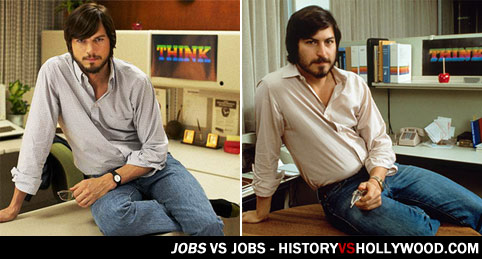
Actor Ashton Kutcher (left) recreates a familiar photo of the real Steve Jobs (right) posing on a desk at Apple headquarters.
Why did Steve drop out of Reed College?
There are a few reasons he attributes to his decision. For one, he disagreed with the strict course guidelines given. He wanted to only take classes that were of interest to him. Secondly, he had no idea what direction he wanted to take in life, and he felt like he was wasting his parents' hard-earned money on nothing. Ultimately, he decided to drop out and "trust that it would all work out okay".
Was Jack Dudman (James Woods' character) really okay with him auditing classes after dropping out?
Yes. In researching the Jobs true story, we learned that Jack Dudman, the dean of students at Reed College in Portland, Oregon, permitted Steve Jobs to audit classes and stay in dorms after dropping out six months into his education. Jack was impressed, "He had a very inquiring mind that was enormously attractive. He refused to accept automatically received truths and he wanted to examine everything himself." He spent an additional 18 months dropping in.
Was Steve Jobs a fruitarian?
Yes, at one point he was. He always followed strict diets, which varied at different times in his life. He went through phases of being a fruitarian, a vegan, a vegetarian and he often dabbled in fasting. He believed his diets would prevent body odor so he rarely showered. His assumption was incorrect and was a problem for various companies he worked for, including Atari and Apple.
Was he forced to work at night for Atari due to complaints from co-workers about hygiene and attitude?
Yes. After landing the job by simply walking into Atari and refusing to leave until he was hired, a number of complaints came in from his colleagues. In an effort to appease everyone, his boss, Nolan Bushnell, allowed him to work at night instead.
Did Steve Wozniak and Steve Jobs build the video game Breakout for Atari?
Yes. In 1975 Nolan Bushnell, the founder of Atari, Inc., envisioned a single player Pong game and he asked Steve Jobs to design it. That game became known as Breakout. Unlike what is shown in the Jobs movie, Bushnell counted on the fact that Steve Jobs would recruit Steve Wozniak to help him design the game, knowing full well that Wozniak was the better engineer. "I looked at it as a two-for-one thing," recalls Bushnell. -Steve Jobs by Walter Isaacson
Did Steve lie to Woz about how much money Atari paid him for the game?

Woz (left) and Jobs working on the Apple II circa 1976.
Did Steve Wozniak really create the first display connected computer?
According to the real Steve Wozniak, "Sunday, June 29, 1975 was pivotal. It was the first time in history anyone had typed a character on a keyboard and seen it show up on their own computer's screen right in front of them." -iWoz book
Did Wozniak really have a Dial-A-Joke line?
Yes. According to his book iWoz, he created the line where callers dialed in for a joke and an answering machine would give them a Polish joke for the day. Occasionally, he would answer the phone himself which happens to be how he met his first wife, Alice Robertson. This venture lasted a few years but caused headaches for a number of people who had similar numbers that were accidentally being dialed. He changed it several times to more foolproof phone numbers but it never helped. Eventually, he shut it down due to costs.
Was one of the possible names for the company really Enterprise Computers?

A fully assembled Apple I computer with wooden casing (Smithsonian). Originally sold for $666.66, collectors have paid as high as $671,400 at auction.
Why is Apple Computers named Apple?
The name Apple came from Steve Jobs and was picked for a variety of reasons. Although it was not depicted in the movie, the true story shows that the fruitarian Jobs often frequented a 220-acre apple farm turned commune called the All One Farm outside of Portland. Daniel Kottke accompanied him on his visits. He had just returned from one such trip when he and Woz were deciding on a company name. He viewed Apple as simple, fun and not intimidating, which was the opposite of how people currently viewed computers. Like in the Jobs movie, it was also noted that it would come before Atari in the phonebook, an added bonus. Wozniak did remark about issues with The Beatles' Apple Records name, but perhaps it was for the better since they both were fans.
Was Apple Computer started in the Jobs family's garage?
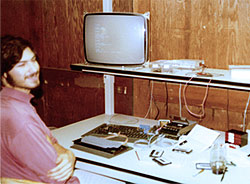
Steve Jobs in his family's garage (the "Apple Garage") in 1976.
Was Steve Jobs's real childhood home featured in the movie?
Yes. Scenes featuring the exterior of the family home were shot at Steve Jobs's former childhood home in Los Altos.
Did the owner of the Byte Shop really expect a more complete product?
Yes. Byte Shop owner Paul Terrell had been expecting a more complete product, not just boards. They included no power supply, case, monitor or keyboard. Like in the movie, Jobs convinced him to accept the order and pay.
What was Rod Holt's initial role at Apple?
Rod was brought in to design a new power supply for the Apple II computer so that it would not overheat, eliminating the need for an internal fan. He is responsible for creating the revolutionary switching power supply, which is significantly lighter due to the fact that it did not require a transformer.
Did Jobs really refuse to give founders' stock to Daniel Kottke when Apple Computer went public?
Yes. Although he could have been awarded founders' stock, Jobs and the board decided not to allow it. He said that since Kottke was not high enough in the company and not salaried that he did not meet the criteria to receive options. He was not the only worker to get shortchanged in the deal. Steve Wozniak took it upon himself to create what he fondly refers to as The Woz Plan. He allowed employees to buy 2,000 shares a piece at $5 a share, which forty employees did. In addition to this, he remained loyal to those jilted by Jobs. He gave shares to Dan Kottke, Chris Espinosa, Randy Wiggington and Bill Fernandez because of their pivotal roles in the first stages of Apple. The company went public December 12, 1980.
Did the real Steve Jobs sign for visitation rights of Lisa Nicole Brennan Jobs?
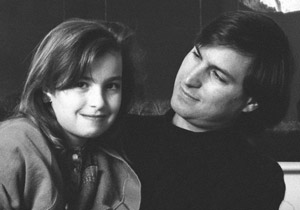
Steve Jobs (right) with his daughter Lisa in the early 1990s.
Was the Apple Lisa computer named after his daughter?
Yes. During our investigation into the Jobs movie true story, we discovered that this is true. However, he only admitted it years later. The acronym Local Integrated Systems Architecture was used to explain the name before he fully acknowledged that she was, in fact, his daughter.
Was an ad taken out to taunt IBM?
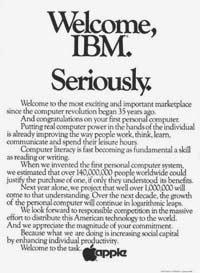
(Click to Enlarge) Apple's 1981 ad "welcoming" IBM into the PC marketplace.
Was the overpricing of the Macintosh the reason for the loss in sales?
Steve believes that it was and blames CEO John Sculley for the failure. "It's the main reason the Macintosh sales slowed and Microsoft got to dominate the market," insists Jobs. Sculley and Jobs had debated the price and in the end Sculley won, pricing it $500 more than expected in order to cover upgrades and marketing costs. The price was a whopping $2,495 and is believed to have alienated the average user client base for which they were striving.
Why did Steve Wozniak quit?
In February 1981, Woz was in a plane crash that caused him to develop amnesia. At this point, he took some time away from Apple. Once his mind cleared he decided to finish college at the University of California, Berkley under the name Rocky Raccoon Clark. Upon returning to work, he found that he had lost his drive for it and was busy with other interests. As a part of the Apple II team, Wozniak felt underappreciated and realized that he preferred a smaller, tight-knit company atmosphere. When the idea of a universal remote control came to him, he decided to leave and start a new company called CL 9 (short for Cloud 9 which was already taken). Unlike what is seen in the movie, he did not go to Steve to let him know about his decision. He went to his Apple II division engineering boss and informed him. Jobs found out through a piece in the Wall Street Journal. Wozniak insists that he did not leave because he was mad at Apple but simply because he had a new interest, the remote. Jobs appears to have held a grudge for a time and even disrupted the remote's manufacturing process by stopping a company associated with Apple from designing the casing for the remote. -iWoz book
When did Steve Jobs come back to Apple?
On December 20, 1996, it was announced that Jobs would come back as a part-time advisor, which he did in January of 1997. CEO Gil Amelio resigned that July and on September 16, 1997, Steve Jobs became the iCEO (short for interim CEO).
Did Jobs really dump 1.5 million shares of Apple stock?
Yes. The real Steve Jobs had received the shares as well as cash for the purchase of his company NeXT. A stipulation required that he hold the shares for at least six months and was to inform the company if he was selling them. He didn't. He dropped his 1.5 million shares without informing CEO Gil Amelio and proceeded to lie to him about it when asked directly. Gil only found out after the SEC filing revealed that Jobs was the seller. Jobs claimed that he thought the company was headed down and wanted out, but he was too embarrassed to admit it. Later, he claimed that he didn't think he needed to tell him. Some believe that this was all part of his plan to become CEO of Apple by making Gil look incapable. Soon after, Gil was removed and Steve was offered the position.
What job did Jonathan Ive have at Apple Computers?
Jony Ive was the head of the design team when Steve returned. The pair collaborated on the iMac and his simplistic design work can be seen on all new products. You can thank him for choosing the iconic pure white color of the iPod and headphones we see everywhere today.
Did Steve ever meet his biological parents?
After his mom died and he got the okay from his dad, he found his biological sister Mona and his mother Joanne Simpson. They all developed a good relationship over the years, but he refused to meet his father who had abandoned them when Mona was five. (Keep in mind that he had abandoned his own daughter Lisa and was trying to mend their relationship. It seems Steven believed that his father should have done the same for the child he abandoned as well.) Through his sister, he learned that he had coincidentally already met his father at a restaurant he had frequented. His father later discovered online that Steve was his son but respected Jobs' wish for him not to have contact.
Steve Jobs Speeches, Interviews and Related Video
Explore the Jobs movie true story through the videos below. Watch the iconic Apple '1984' commercial and view Steve Jobs speeches from Apple Events, including the unveiling of the Macintosh and the iPod.
WATCH Steve Jobs Introduces the Famous '1984' Apple CommercialDuring the 1983 Apple Keynote, Steve Jobs
unveils the famous '1984' Apple commercial
directed by sci-fi director Ridley Scott
(Alien, Blade Runner).
The ad debuted for the masses in 1984
during Super Bowl XVIII. It features a
female athlete entering an auditorium and
hurling a sledgehammer through a large
video screen displaying "Big Brother," who
symbolizes Apple's then rival, IBM. |
WATCH Steve Jobs Hosts the Macintosh Software Dating Game Featuring Bill Gates (1983)In October of 1983, Steve Jobs invited
Microsoft Chairman Bill Gates and two
other software CEOs to an Apple Event. He
pretended to host what was titled, "The
Macintosh Software Dating Game." Jobs
questions Gates, who offers praise for the
Macintosh, stating that it's "really new
and really captures people's imagination."
Gates says he expects Microsoft to get
half of its 1984 revenues from its
software for the Macintosh, a statement
that makes Steve Jobs giddy. |
WATCH Steve Jobs Unveiling the Macintosh on January 24, 1984Steve Jobs unveils the Macintosh computer
at Apple's Annual Shareholders Meeting on
January 24, 1984. He touts its 128K bytes
of RAM and its three-and-a-half inch disk
drive that he states will be the "disk of
the '80s." He also emphasizes the
Macintosh's incredible black and white
screen and built-in voice sound. |
WATCH Apple Steve Jobs The Crazy Ones Commercial (1997)Steve Jobs narrates Apple's first Think
different commercial that begins, "Here's
to the Crazy Ones". Jobs version of the
1997 commercial never aired. Instead,
actor Richard Dreyfuss did the voice-over
for the final version, leaving the Jobs
version largely unseen. |
WATCH Steve Jobs Introduces the Original iPod in 2001This is the real-life version of the scene
that the Jobs movie opens with, a
low-key Special Event that took place at
the Apple Town Hall on October 21, 2001.
During his address, Steve Jobs unveils a
new portable music device, the iPod. He
emphasizes its incredible ability to hold
1,000 songs. |
WATCH Steve Jobs Stanford Commencement Speech 2005Watch Steve Jobs Stanford Graduation
Speech from 2005. Jobs, the
co-founder of Apple Computer and
Pixar Animation Studios, tells
three stories from his life. The stories
include the benefits that came from
dropping out of Reed College, why he got
fired from Apple at age 30, and his
experience with facing death after being
diagnosed with pancreatic cancer. |
WATCH Jobs Movie TrailerWatch the Jobs movie preview for
the Steve Jobs biopic starring Ashton
Kutcher as the legendary innovator. Actor
Josh Gad portrays Steve Wozniak, the
co-founder of Apple Computer. The movie
chronicles Steve Jobs life from 1971 to
2000. |
Link-to-Learn More:
